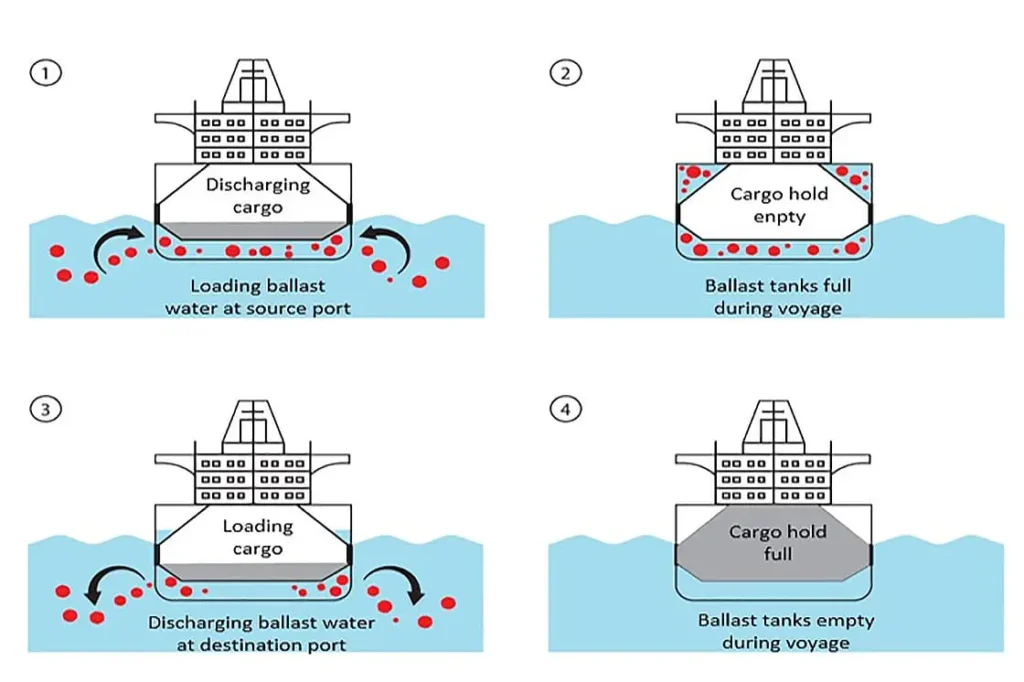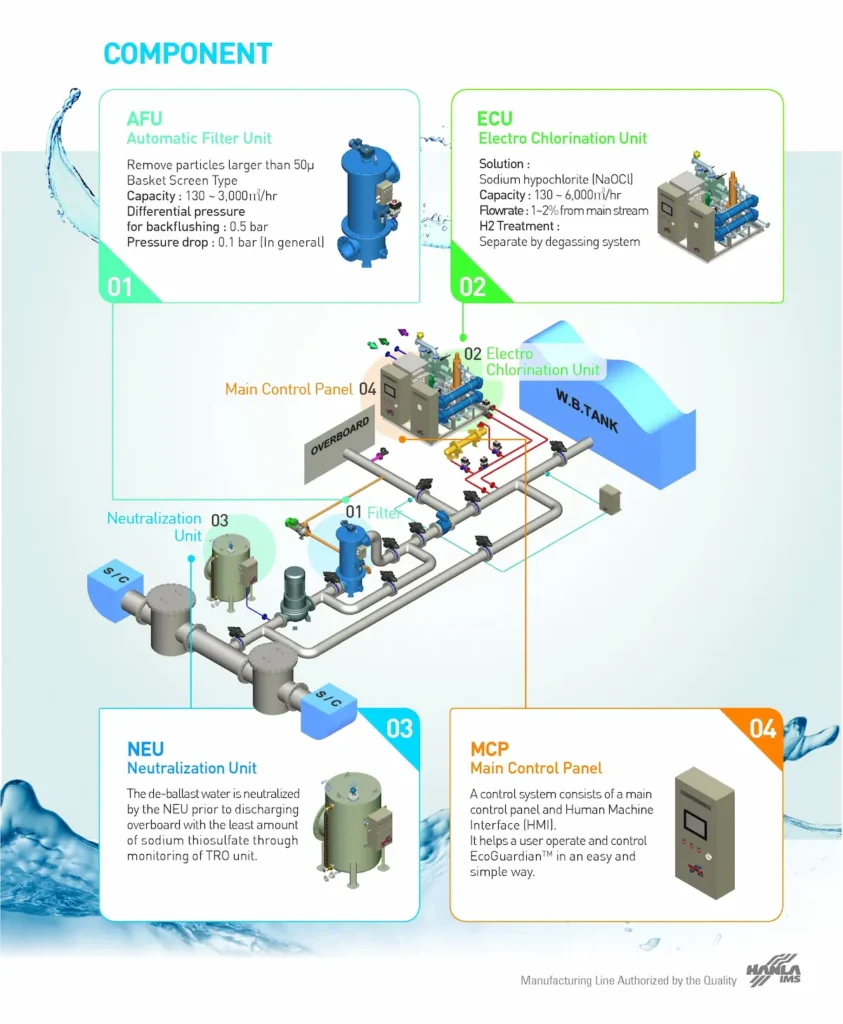A Ballast Water Treatment System (BWTS) is an essential part of modern shipping, used to control the transfer of potentially harmful aquatic organisms and pathogens in the ballast water of ships.
Ballast water is taken on by ships for stability and balance. It’s typically loaded at the port of departure and discharged at the port of arrival.

The issue is that this water often contains various marine species, including bacteria, small invertebrates, eggs, cysts, and larvae of various species that are not native to the destination port. When these non-native species are released into a new environment, they can become invasive and disrupt local ecosystems, outcompete native species, and lead to significant ecological and economic damage.
To combat this, the International Maritime Organization (IMO) adopted the Ballast Water Management Convention, which requires ships to manage their ballast water to remove or render harmless these biological materials. This is where BWTS comes into play.
What Is Ballast Water Treatment System Working Principle?
The working principle of a Ballast Water Treatment System (BWTS) revolves around removing or neutralizing organisms and pathogens in the ballast water of ships to prevent the spread of invasive species and protect marine ecosystems.

Different BWTS use various technologies, but the general principle remains consistent: to treat the water sufficiently before it is discharged into a new environment. Here are the key stages and methods used in the process:
- Filtration:
- Principle: Physical removal of large organisms and sediments.
- Process: As ballast water is taken onboard, it passes through a filter system that captures larger organisms and sediment. This is often the first stage of treatment, especially in systems that use additional methods for dealing with smaller organisms.
- UV Radiation:
- Principle: Disinfection using ultraviolet light.
- Process: The ballast water is exposed to UV light, which damages the DNA and cellular structures of microorganisms, rendering them incapable of reproduction and growth. This method is effective against a wide range of organisms but does not remove them from the water.
- Chemical Disinfection:
- Principle: Use of chemicals to kill or inactivate organisms.
- Process: Chemicals like chlorine or ozone are added to the ballast water. These chemicals react with the organisms, leading to their destruction or deactivation. The type and amount of chemicals used depend on various factors including environmental regulations.
- Deoxygenation:
- Principle: Removal of oxygen to kill aerobic organisms.
- Process: This method involves purging the ballast water of oxygen, often by injecting inert gases like nitrogen. The lack of oxygen suffocates aerobic organisms. This method is less common due to its complexity and potential safety issues.
- Heat Treatment:
- Principle: Using thermal energy to kill organisms.
- Process: Ballast water is heated to a temperature high enough to kill microorganisms. This method can be energy-intensive and is generally not as common as other methods.
After treatment, the water is stored in the ballast tanks and, when the ship reaches its destination, the treated water is discharged.
The efficiency of a BWTS is evaluated based on its ability to meet international standards set by organizations like the International Maritime Organization (IMO), ensuring that the discharged water has minimal ecological impact.
Each method has its advantages and limitations, and the choice of a specific BWTS often depends on factors like the ship’s operational areas, environmental regulations in those areas, and the ship’s ballast water capacity.
What Are The Types Of Ballast Water Treatment Systems?
Ballast Water Treatment Systems (BWTS) come in various types, each using different technologies and methods to treat ballast water and prevent the spread of invasive species.

The choice of a specific system depends on factors such as the ship’s operating route, the volume of ballast water, environmental regulations, and the ship’s design. The main types of BWTS are:
- Mechanical Treatment Systems:
- Filtration: This method involves physically removing organisms and sediments from the ballast water using a filtration system. It’s effective for larger organisms and particles but may be combined with other methods to deal with smaller organisms.
- Physical Disinfection Systems:
- Ultraviolet (UV) Radiation: UV systems expose ballast water to ultraviolet light, which damages the DNA of microorganisms, rendering them incapable of reproduction. This method is chemical-free but may be less effective in turbid (murky) water.
- Heat Treatment: Using heat to raise the temperature of the ballast water to a level that kills organisms. This method is energy-intensive and less commonly used.
- Chemical Treatment Systems:
- Chemical Injection: Involves adding biocides or other chemicals to the ballast water to kill organisms. The choice of chemicals depends on safety, environmental regulations, and effectiveness against a range of organisms.
- Electrochlorination: This method generates chlorine or other disinfectants on board by electrolysis, using seawater. It’s effective but may produce harmful byproducts and is generally used in saline or brackish waters.
- Deoxygenation:
- This method removes oxygen from the ballast water, typically by injecting inert gases like nitrogen. It’s effective against aerobic organisms but is less common due to its complexity and safety concerns.
- Combination Systems:
- Many BWTS combine two or more of the above methods to increase effectiveness. For example, a system might use filtration followed by UV radiation or chemical disinfection. These combination systems can handle a wider range of water qualities and organisms.
Each type has its own advantages and limitations. Mechanical systems are straightforward but might not be effective against very small organisms. Physical systems like UV are environmentally friendly but can struggle with turbid water. Chemical systems are often very effective but have to deal with the safe handling and storage of chemicals, as well as potential environmental impacts. The choice of system is often a balance between effectiveness, environmental impact, operational costs, and compliance with international and local regulations.
What Are Ballast Water Treatment Systems IMO Regulations?
The International Maritime Organization (IMO) has established regulations for Ballast Water Treatment Systems (BWTS) to prevent the spread of invasive aquatic species, which can have a detrimental impact on marine ecosystems, biodiversity, and the economy.
These regulations are outlined in the International Convention for the Control and Management of Ships’ Ballast Water and Sediments, also known as the Ballast Water Management (BWM) Convention. The key aspects of these regulations include:
- Ballast Water Management Standards:
- D-1 Standard (Ballast Water Exchange): Requires ships to exchange their ballast water in open seas, away from coastal waters, to minimize the risk of introducing invasive species. This standard is considered a temporary solution until a ship can install a treatment system meeting the D-2 standard.
- D-2 Standard (Ballast Water Performance): Specifies that ships must treat their ballast water to remove or render harmless certain quantities of organisms and pathogens. The standard sets specific limits on the size and concentration of viable organisms allowed in discharged ballast water.
- Ballast Water Treatment System Approval:
- BWTS must be approved by the IMO based on guidelines that assess their efficacy in meeting the D-2 standard, without causing undue harm to the environment, human health, property, or resources.
- Ballast Water Record Book:
- Ships are required to maintain a ballast water record book to document the management and treatment of ballast water. This includes details of when and where ballast water is taken on board, treated, and discharged.
- Ballast Water Management Plan:
- Each ship must have a BWM plan specific to the vessel, detailing how ballast water management is to be conducted.
- Survey and Certification:
- Ships must be surveyed and certified in accordance with the BWM Convention. This includes initial, renewal, and additional surveys to ensure compliance with the standards.
- Monitoring and Enforcement:
- Port States have the authority to inspect visiting ships to ensure compliance with the BWM Convention. Non-compliant ships can be penalized, which may include detention.
- Phased Implementation:
- The BWM Convention has a phased implementation schedule, allowing shipowners time to comply with the D-2 standard. This schedule is based on the ship’s ballast water capacity and the date of construction.
- Exceptions and Exemptions:
- Certain exemptions may be granted under specific circumstances, such as ships operating within a defined area or ships that discharge ballast water at the same location it was taken on board.
These regulations aim to balance environmental protection with the practicalities of global shipping operations. Compliance with the BWM Convention is crucial for the shipping industry to minimize the ecological threat posed by invasive aquatic species.
- Types of Gas Carriers as per IGC Code – April 22, 2025
- Wind-Assisted Propulsion Systems (WAPS): A Game Changer for Maritime Decarbonization – February 6, 2025
- 10 Boat Salvage Yards in California – January 25, 2025



